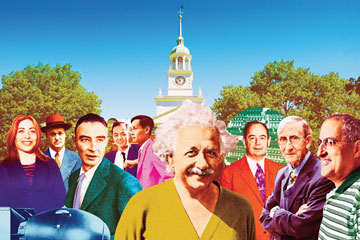
(5 of 6)
One recent flare-up featured shrimp running on treadmills. After 2008, a series of videos of shrimp running on tiny treadmills for a government-funded study went viral and became political shorthand for the feds' profligacy. The athletic crustaceans re-emerged in 2011 when Senator Tom Coburn included them in a report on wasteful spending by agencies like the National Science Foundation. (The shrimps' treadmill, which one of the scientists told NPR cost only $1,000, was part of a large project about ecosystems valuable to the shrimping industry, it turns out.) In March, in an amendment introduced by Coburn, the Senate's budget stipulated that political-science research should not be funded unless it has an impact on the country's economy or security, which may have a chilling effect on the National Science Foundation program to fund political-science research. Research defenders don't deny the existence of waste in science, but they caution that today's silly-sounding work can be tomorrow's breakthrough. An economic study into the matching of college roommates produced an algorithm that has made kidney-transplant systems more efficient, while a project to build a "family tree" of Web links by Stanford graduate students Larry Page and Sergey Brin turned into Google.
iPhones--in Space
The institute feels far away from those fights. While Voevodsky types proofs into a computer in one room on campus, in another Patrick Geary, a medieval historian on the faculty, is using ancient DNA extracted from the teeth in skeletons lying in cemeteries in Italy and Hungary to map the migration of European peoples. Archaeology, the traditional tool for this, he says, is imprecise. "If someone tried to figure out who was at the institute in 1,000 years based on our cars, they might assume we were mostly German and Japanese." It's a long and expensive project that would have been difficult at a university. If it works--and there is no guarantee it will--Geary could find that ancestry across European countries is more similar than we realize, which has implications in Europe's pretty nasty contemporary debate about nationalism.
On a recent Friday morning at the institute, at the astrophysics department's morning coffee, everyone was having fun. A dozen physicists, dressed in hoodies or khakis and button-downs--most looking well under 40 and all but one male--were sitting around a conference table in front of a blackboard. James Lloyd, an astronomer from Cornell, had come to talk about his work developing small satellites. After he presented the meat of his project, the scientists lured him into more far-fetched discussions. "If I take my iPhone into a space station, can I connect to Verizon?" asked a young aptly named Indian-American scientist, Aristotle Socrates, as everyone laughed. "We could create a global, intergalactic network of iPhones," he said. Later Socrates explained that it was an inside joke, a reference to a time when Boaz Katz, an Israeli astrophysicist, proposed launching millions of iPhones into the galaxy as a way of communicating with other solar systems. When I asked Katz whether they had been joking or serious, he said it was a little bit of both. With astrophysics, he explained, you need a "speculative meter" to indicate what is "rigorous and what is still fantasy."
